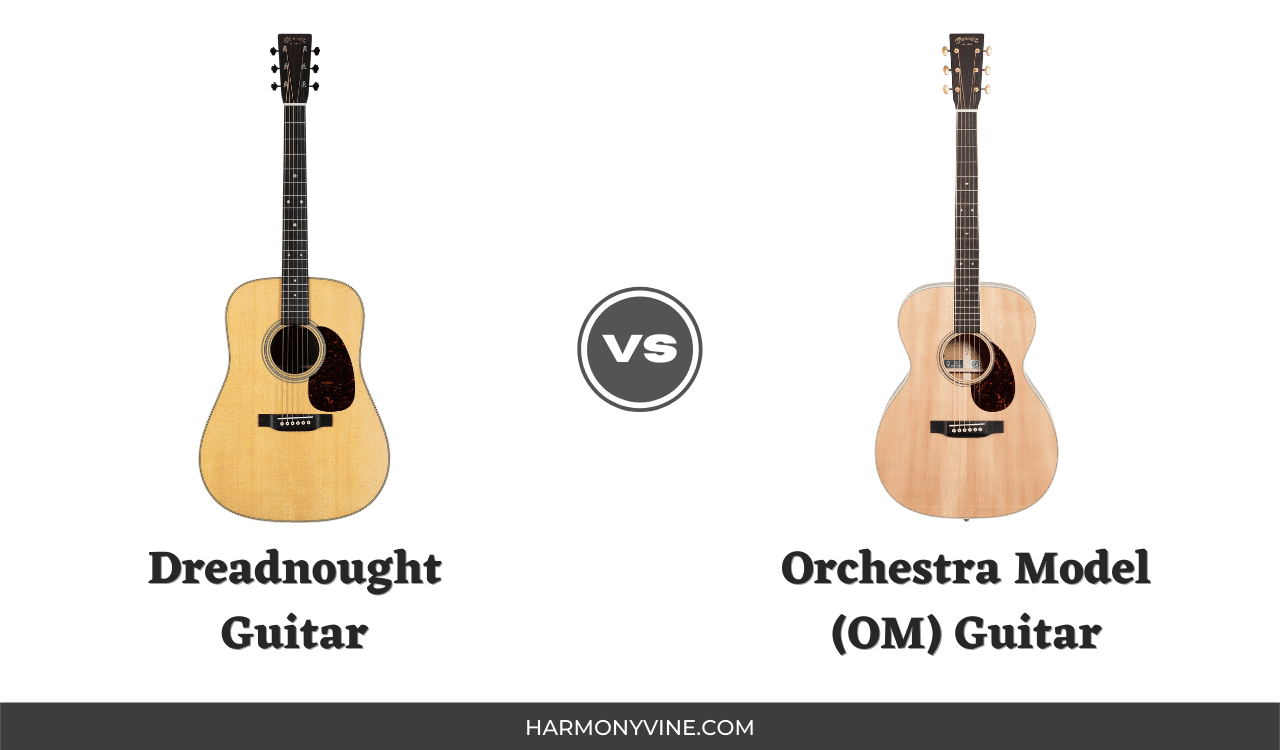Dreadnoughts and OM guitars are two of the most popular acoustic guitar body types in the market today.
Why is that? And which one should you get?
Most importantly, which one fits your style best?
Here’s everything you need to know about Dreadnought vs OM Guitars!
What is a Dreadnought Guitar?
Dreadnought guitars were developed by Martin Guitars in 1916 and have become the standard template emulated by other acoustic guitar manufacturers. Chances are if you see an acoustic guitar on stage, it’s a dreadnought.
Dreadnoughts originally came with 12 frets instead of the current 14 fret guitars. The “longer” neck came about due to popular demand. Traditionally, dreadnoughts have a squared-off look.
Today, with the number of manufacturers vying for attention, it isn’t unlikely to find samples with cutaways for easier access to the higher frets.
A typical dreadnought has these measurements:
- Body length: 20 inches (508mm)
- Body width: 15.6 inches (396.9mm)
- Body depth: 4.8 inches (123.8mm)
Dreadnoughts owe their unique tonal qualities to this oversized, cavernous body engineering. It has such a powerful sound and appealing sonic qualities that it is regarded as the singer-songwriter’s best friend.
Although Martin Guitars dominated this market since time immemorial, other companies have managed to gain the same strong following over the years.
Companies like Takamine, Yamaha, Taylor, Gibson, and Epiphone all produce note-worthy dreadnoughts sought after by the best artists.
Artists Who Use a Dreadnought
- Joni Mitchell
- Neil Young
- Kurt Cobain
- Garth Brooks
- The Beatles
- Johnny Cash
- Woodie Guthrie (considered the best country singer)
The list goes on and on. Everyone loves dreadnought guitars.
What is an OM Guitar?
Orchestra Model or OM guitars came about as an improvement over the 000 guitar shape simply by increasing the scale length to accommodate 14 frets instead of 12. At first glance, you’d think it was a dreadnought, only smaller.
But imagine being able to tell a guitar from across the room just by its pickguard alone. That’s basically what you can do with an OM guitar. Or you can just look at the guitar’s waist. An OM has a tighter waist than a dreadnought.
The dreadnought also typically has a pickguard extending from the base of the neck to the bridge. The OM has a smaller one that’s half the size, offset and radiating from the center of the soundhole to the bridge.
Although this holds true for Martin guitars, this might not be applicable to other manufacturers’ samples.
A typical OM guitar has these dimensions:
- Body length: 19.3 inches (492.1mm)
- Body width: 15 inches (381mm)
- Body depth: 4.1 inches (104.8mm)
OM guitars are also elegantly styled, making them the more cost-effective alternative to owning a dreadnought from any of the companies mentioned in the previous section.
Artists Who Play OM Guitars
- Eric Clapton
- Bob Dylan
- John Mayer
- Bruno Mars
These artists don’t exclusively just use OM guitars. They have been known to play dreadnoughts also. In fact, if everyone had the money, they’d be buying a Martin dreadnought too just for the experience alone.
Dreadnought vs OM Guitars: Differences
Now, let’s move on to the main differences between a dreadnought and an OM guitar. Let’s start with the body shape.
Body Shape
Dreadnoughts have a very distinct squared-off body. Although recent innovations to the dreadnought body have brought about cutaways and improved waists, the classic shape remains.
Here are the approximate dimensions of these two guitar body shapes:
| Dreadnought | Orchestra Model | |
| Scale Length | 25.5” | 25.4” |
| Body Length | 20” | 19.4” |
| Body Depth | 4.8” | 4.1” |
| Lower Bout Width | 15.6” | 15” |
| Upper Bout Width | 11.5” | 11.25” |
| Waist | 10.75” | 9.4” |
An OM guitar is slightly smaller than a dreadnought but looks basically the same sans the premium stylings and oversized pickguard.
As mentioned above, the pickguards of these two are different in size with the OM going for a more minimalistic approach than the dreadnought’s flared pickguard.
The waists on these two are also very different. Dreadnoughts have a wider waist while OM guitars have a more “pinched” appearance.
Sound
There are a couple of things I’d like you to know when it comes to dreadnought vs OM sound.
Owing to its larger body, dreadnoughts have a louder and richer tone. This is because it was initially designed to accommodate stages where the only sound input would be the mic pointed at the soundhole.
These days, acoustic guitars come with pickups so this has made that argument moot.
An OM guitar on the other hand was designed for more delicate playing. It has a brighter tone but comes off as much more subtle than what a dreadnought produces. Strumming the OM will produce a more reined-in sound than what a dreadnought produces.
Individually plucking the strings brings out the most difference between the two. The dreadnought has a deeper midrange sound while the OM performs better in higher registers.
Versatility
Dreadnought guitars were primarily used for bluegrass music.
But thanks to its popularity, it has crossed over to genres from country to rock, to blues, pop, and any other type of music requiring a rich acoustic sound.
Dreadnoughts thrive in all types of musical situations.
OM guitars on the other hand are great for jazz, funk, light acoustic work, and pop. This is due to its more subdued tonal persona.
Where it truly shines is when the individual strings are plucked. This makes it perfect for playing counterpoint to strummed accompaniment.
Gentlemen, Choose Your Weapons
Why Choose Dreadnought?
Dreadnoughts are perfect for a lot of musical settings. It can be loud or subtle as needed. You may need to manipulate the volume by placing it nearer or further away from the mic or simply turning the knobs.
Dreadnoughts were designed to be the ultimate accompaniment tool. This makes it “boomy” on the lower strings and brighter on the upper strings. An artist, in effect, can play both rhythm and bass parts without worrying about clashing frequencies with this guitar onstage.
The guitar’s dynamic tonal range is acceptable for pop, rock, blues, and other contemporary settings.
Why Choose OM Guitars?
If you play a more delicate type of music, you would benefit from using an OM guitar. This is designed for fingerstyle players who prefer their notes to ring out as they are plucked.
OM guitars are perfect for intimate settings where the music is meant to provide a light ambient tone rather than be upfront.
The best genres to play OM guitars with are pop, jazz, and light blues. Anything that doesn’t require any heavy-handed picking.
And if you’re looking for a collector’s item, an OM isn’t the most obvious choice. But in time, people will notice this dreadnought’s little brother and realize it’s worth as much as the bigger guy.
Final Thoughts on OM vs Dreadnought Guitars
Having used a Martin dreadnought before, I could say it is a life-changing experience. This is after I’ve had the privilege of using a Takamine dreadnought and also having owned a Yamaha dreadnought variant before.
All other acoustic guitars I’ve played with since have not matched up to that magical night in the recording booth.
The Martin dreadnought just vibrates in a different way which gives whatever you’re playing more “life.” This type of feedback is highly enjoyable and will make you want to play more songs as the night progresses.
I’ve also played an OM guitar before and what I can say about it is that if you’re looking for notes that ring out in the higher registers, this is the one for you.
We recorded a couple of songs with the OM playing single notes in the background and managed to fill the higher frequencies with pleasant sounds.
As a basic rule of thumb, if you’re playing alone, you’re better off with a dreadnought. If you have someone to play bass or keyboards, the OM is a great guitar to complement the bottom end.
FAQs: Dreadnought vs OM Acoustic Guitars
u003cstrongu003eAre OM Guitars Louder Than Dreadnoughts?u003c/strongu003e
No. The dreadnought is usually louder than the OM guitar. Dreadnoughts have bigger dimensions therefore a bigger chamber for the sound to resonate.
u003cstrongu003eOM Guitar vs Dreadnought: Which is Better for Fingerstyle?u003c/strongu003e
The OM guitar is better as it is targeted to cater to fingerstyle guitarists. Don’t get me wrong though. The dreadnought is no slouch in the fingerstyle department. The OM is just plainly better, as it was designed to cater to that crowd.
u003cstrongu003eCan You Really Tell an OM Guitar from a Dreadnought with a Single Look?u003c/strongu003e
If we’re talking about u003ca href=u0022https://www.martinguitar.com/u0022 target=u0022_blanku0022 rel=u0022noreferrer noopeneru0022u003eMartin guitarsu003c/au003e, it’s pretty easy to spot an OM guitar from a dreadnought. The size alone will tell you which is which. But one clever feature they’ve included to help us determine which is a dreadnought and which is an OM is the pickguard.
u003cstrongu003eWhich is Better Dreadnought vs OM For Strumming?u003c/strongu003e
If you’re playing alone, a dreadnought is ideal for strumming. For fingerpicking or complementing bass or keyboards, consider an OM guitar.
u003cstrongu003eHow Do Dreadnoughts and OM Guitars Differ in Size?u003c/strongu003e
Dreadnoughts have a larger body with squared-off shoulders, while OMs are smaller and have a tighter waist. OM guitars sit lower on the lap due to their distinct waist shape.

I’m Pranshu. I’ve been a passionate guitarist, keyboardist, and music producer ever since I got my hands on a keyboard as a small child.
With Harmonyvine, my goal is to share tips and knowledge about music and gear with you. I also enjoy recording music and guitar covers, which you can check out on my Instagram page.

